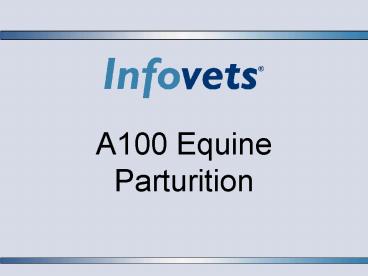A100 Equine Parturition - PowerPoint PPT Presentation
Title:
A100 Equine Parturition
Description:
A100 Equine Parturition Vaccination of the Pregnant Mare A vaccination program should include vaccinations against: Rhinopneumonitis in the 3rd, 5th, 7th, & 9th ... – PowerPoint PPT presentation
Number of Views:88
Avg rating:3.0/5.0
Title: A100 Equine Parturition
1
A100 Equine Parturition
2
Vaccination of the Pregnant Mare
- A vaccination program should include vaccinations
against - Rhinopneumonitis in the 3rd, 5th, 7th, 9th
months of pregnancy. - Four-six weeks prior to foaling, the following
should be given - Tetanus
- Equine Encephalomyelitis
- Influenza
3
Foal Antibody Absorption
- The placenta does not allow transfer of maternal
antibodies to the fetus. - However, the antibodies can be passively
transferred to the newborn foal through the
mothers colostrum. - The foals intestine will absorb the antibodies
only during the first 24 hours after birth. - The greatest absorption occurs during the first
few hours.
4
Signs of Parturition
- Udder enlargement abdominal milk vein
enlargement - Change in milk color
- Waxed teats (2 weeks to hours before foaling)
- Relaxation of the tail head, croup, and perineal
area
5
Labor and Parturition
- A mares labor is intense and rapid. Usually it
is over within an hour. The owner does not have
time to develop a wait and see attitude. - All of the foals oxygen supply is obtained
through the umbilical cord. A prolonged delivery
can quickly endanger the foal.
6
Stage 1 of Labor
- Uterus begins to contract pushing the foal into
position - The cervix relaxes
- Signs in the mare include
- Restlessness
- Tail switching
- Pacing
- Sweating over neck, chest and flanks
- Frequent urination and defecation
- Elevated tail
7
Stage 1 of Labor
- Move the mare to the foaling area.
- Wash the mares perineal area with an iodine
solution. - Wrap the tail.
- Quietly observe from a distance. The mare will
not give birth unless she feels completely safe.
8
Stage 2 of Labor
- Stage 1 ends when the fetal membranes break,
releasing the amniotic fluid (Water breaks). - Stage 2 begins with intense labor contractions
that push the foal through the birth canal. - This stage usually lasts about 30 minutes. Little
can be done to slow labor or make corrections if
problems arise at this point. - The mare usually lies down during stage 2. It is
best for the foal if she is lying down to prevent
premature rupture of the umbilical cord.
9
Stage 2 of Labor
- Both front feet should appear within 15 minutes
of her water breaking, followed by the nose. - Once the shoulders (the widest portion of the
foals body) are born, the rest of the foal
usually follows shortly. - If the mare has been pushing for 45 minutes and
no sign of the foal has been seen, intervention
is needed quickly if the foal is to survive.
10
Dystocia (Difficulty Giving Birth)
- Older mares may often become exhausted in the
middle of labor and are unable to push the foal
out. - Any deviation from the proper fetal position
(front legs first, head down between the knees
posture) can cause dystocia. - Improper fetal positions would include
- A head or a leg turned down
- A breech foal (backwards)
- Upside down foal
- The presence of twins.
11
Dystocia
- The placenta detaches from the uterine wall
within an hour of stage 2, whether the foal is
born or not. - If the placenta detaches and the foal has not
been born, the foals oxygen supply will be cut
off, and the foal is likely to die. Time is
critical.
12
The Foal
- The newborn foal may have a blue tongue and
bluish white nasal mucous. - Clear the fetal membranes
- If the foal has not started breathing on its own,
put your finger or a piece of straw up its nose. - The umbilical cord should be allowed to break on
its own. It should never be cut.
13
The Foal
- Once the umbilical cord breaks, it should
immediately be treated with iodine. - If the umbilical cord bleeds heavily, tie it off
with a piece of sterilized string. - Make sure the foal has nursed within the first
few hours after birth. - An enema should be administered to the foal to
help pass the meconium.
14
Stage 3 Postpartum
- Stage three is complete when the placenta and
fetal membranes are expelled. - This usually happens 5 to 45 minutes after birth.
- If they have not been passed in two hours, the
membranes are considered retained and a vet
should be called. - Pulling the placenta may leave small pieces in
the uterus which can cause infection, laminitis
or death.
15
Stage 3 Postpartum
- A mare with this condition may appear normal for
the first 48 hours and then, when symptoms
develop, it may be too late. - Occasionally, if the mare has had a very
difficult birth, a serious condition can occur
immediately postpartum where the middle uterine
artery ruptures. This usually happens in mares
older than 15 and is usually fatal. - A nursing mares energy requirements double.
- Colic is relatively common during the first week
postpartum. Soft feed and laxatives should be fed
to the mare.













![book❤️[READ]✔️ Equine Internal Medicine 4th Edition PowerPoint PPT Presentation](https://s3.amazonaws.com/images.powershow.com/10074295.th0.jpg?_=20240708010)
![book❤️[READ]✔️ Equine Internal Medicine 4th Edition PowerPoint PPT Presentation](https://s3.amazonaws.com/images.powershow.com/10074326.th0.jpg?_=20240708013)
![[PDF] DOWNLOAD FREE AAEVT's Equine Manual for Veterinary Technicians PowerPoint PPT Presentation](https://s3.amazonaws.com/images.powershow.com/10075013.th0.jpg?_=20240709066)
![[PDF] Handbook of Equine Parasite Control Kindle PowerPoint PPT Presentation](https://s3.amazonaws.com/images.powershow.com/10075604.th0.jpg?_=202407090710)



![[PDF] Pathways to Pregnancy and Parturition Ipad PowerPoint PPT Presentation](https://s3.amazonaws.com/images.powershow.com/10084335.th0.jpg?_=20240724014)







![[PDF] DOWNLOAD EBOOK Equine Massage: A Practical Guide (Howell Equestr PowerPoint PPT Presentation](https://s3.amazonaws.com/images.powershow.com/10129449.th0.jpg?_=20240911019)
![[PDF] DOWNLOAD FREE Equine Pharmacology PowerPoint PPT Presentation](https://s3.amazonaws.com/images.powershow.com/10129450.th0.jpg?_=20240911019)
![[PDF] READ] Free Equine Surgery: Advanced Techniques PowerPoint PPT Presentation](https://s3.amazonaws.com/images.powershow.com/10129451.th0.jpg?_=20240911019)
